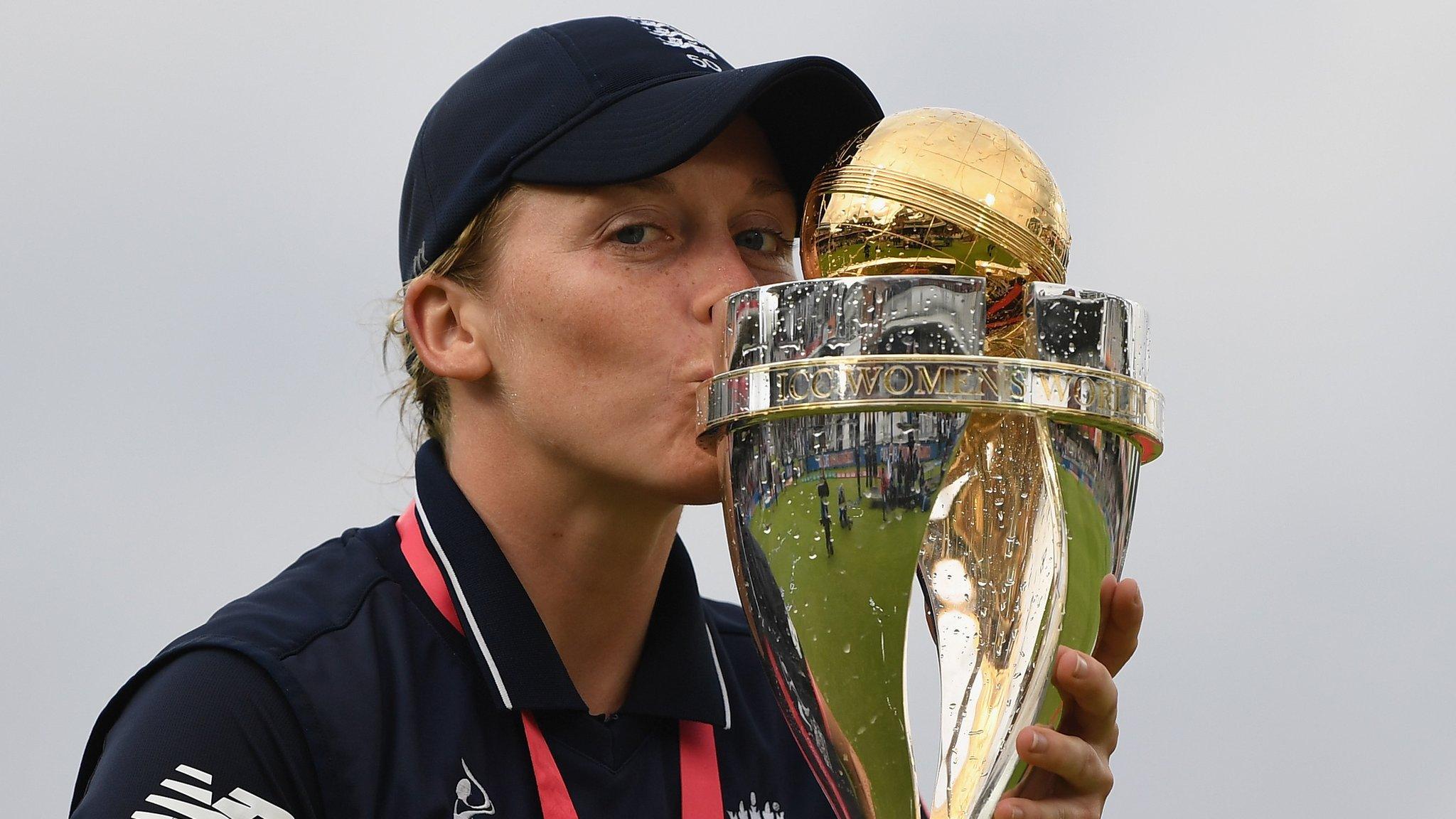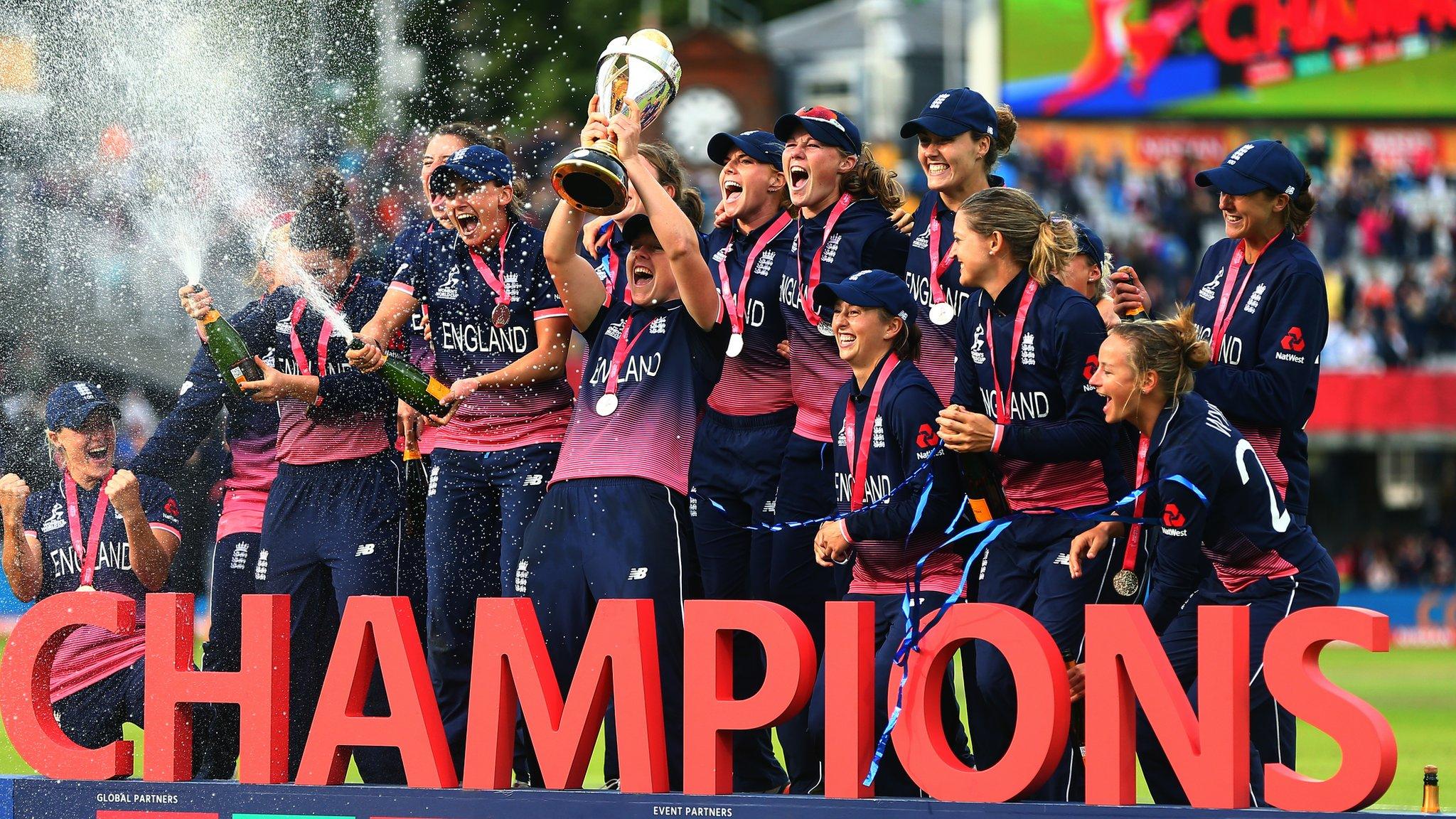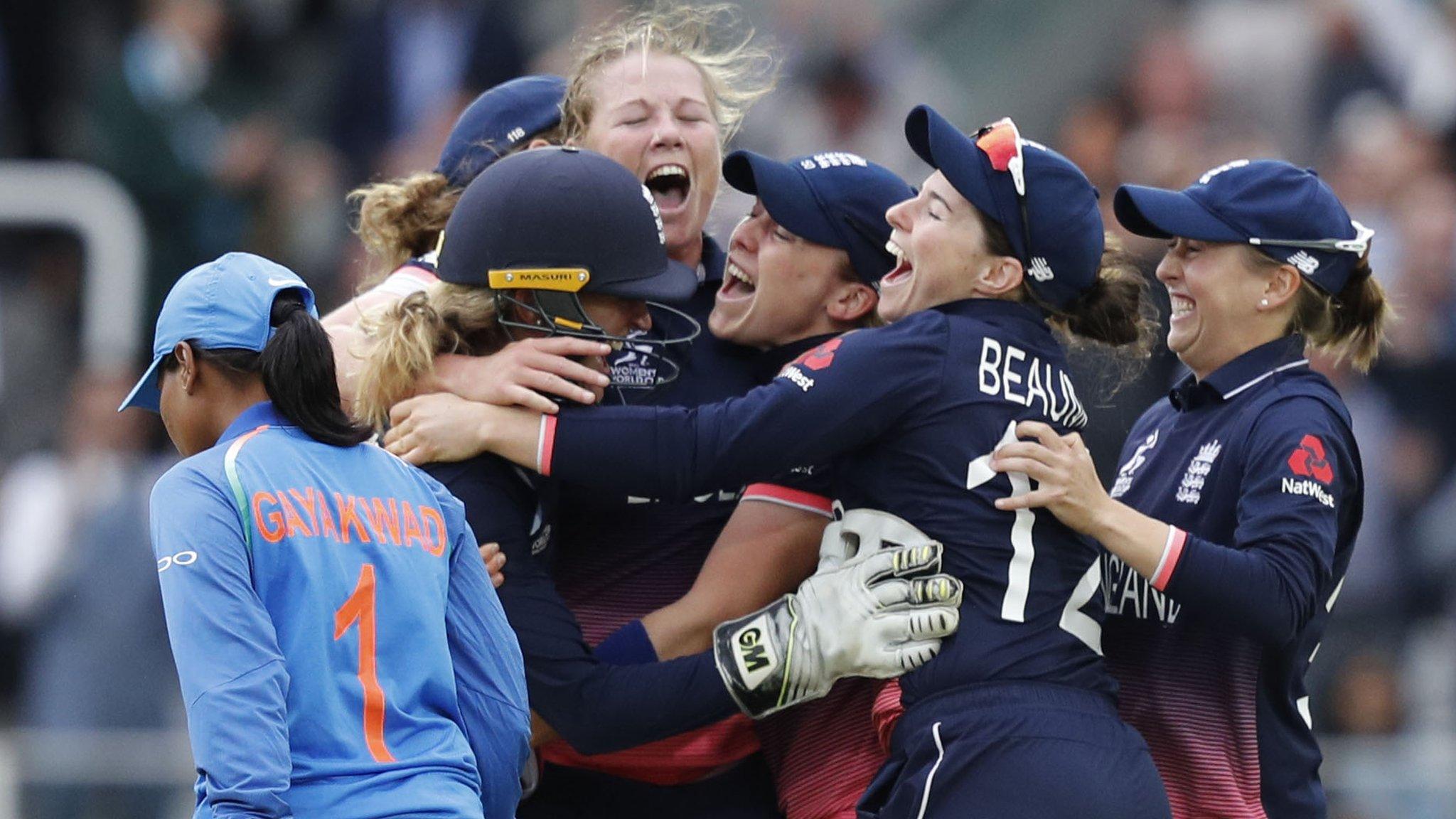England's World Cup win: The transformation of women's cricket
- Published
- comments
When England beat India to win Women's World Cup
If you're going to win the Women's World Cup, it might as well be the biggest ever staged.
When Heather Knight got her hands on the ultimate prize in women's cricket on an emotional Sunday afternoon at Lord's, it marked a triumph not only for England, but the sport itself.
For Knight, kissing the silverware is a world away from four years ago, when she was clinging on to a place in an England side that failed to reach the final.
But her personal transformation, and her team under coach Mark Robinson, is nothing compared to that of the women's game from a 2013 World Cup that was barely befitting of the name.
Held in India, mainly Mumbai, it hardly registered with the locals in a nation where cricket is loved like no other.
Winning the World Cup is a 'watershed' moment - England captain Knight
Its very staging came under threat over a row about the presence of the Pakistan team, who were eventually shifted to the other side of the country - 1,000 miles away in Cuttack - and forced to sleep at the Barabati Stadium.
The women were due to play at Mumbai's iconic Wankhede Stadium, only to be evicted to make way for men's matches. Facilities at venues were shoddy and publicity non-existent.
Although global TV audiences were up, matches were played to near empty stadiums, despite entry being free of charge.
"It was shocking in India," former England batter Ebony Rainford-Brent told BBC Sport. "In a cricket-crazy country, you would expect to see something - posters, adverts - but there was nothing.
"The only people in the grounds were a few family members. It was almost like the cricket wasn't happening."
Now, the World Cup doesn't just seem like a different event, but women's cricket is an entirely different sport.
Free bats and front-page news

The Guardian was among the newspapers to feature England's victory on Monday's front page
The final at Lord's was a fitting conclusion to a tournament that has catapulted women's cricket into the national and international consciousness.
What began with a marketing campaign on the London Underground and in cinemas ended in a sold-out Lord's and the most-watched game of women's cricket in history.
Across the tournament, all matches were shown live for the first time, with more than 50 million watching the group games alone. Over the course of the event, the International Cricket Council expects an 80% increase in worldwide viewership.
More than one million users followed England's final victory on the BBC Sport website, while the hosts' nerve-shredding semi-final victory over South Africa was also front-page news. In the host cities - Bristol, Leicester, Derby and Taunton - 30,000 people visited fan zones.
"Everything you could think of to promote the tournament has been done," added Rainford-Brent. "The investment and energy that has gone into has been incredible. To finish with a packed Lord's ticked the final box."
The moment England won the Women's World Cup
The audience is a new one, too, riding a wave that perhaps began with last year's launch of the Twenty20 Super League, a competition that attracted an average attendance in excess of 1,000, larger than the inaugural season of its football equivalent in 2011.
At the World Cup, 50% of ticket-buyers were women, while 31% of those in attendance were under the age of 16. About 13,000 tickets were given away to schools and every child at Lord's on Sunday received a plastic bat as a souvenir of the incredible final.
Marie, from Surrey, was at the game with seven-year-old daughter Lucy and said: "Lucy's dad played cricket but she has become more aware that women play too.
"We've heard a lot about women's cricket on the radio and now she is more aware that there are opportunities for her in the future if she wants to play sport."
Tom, from London, brought daughters Connie, five, and Cissie, three, to their first game of cricket.
"I thought it would be a fun game for them, with lots of entertainment going on around the edges," he said.
'Women's cricket is everywhere - now is the time'
Youngsters may have Knight, Tammy Beaumont and Anya Shrubsole as their new England heroes and be keen to try their hand at Natalie Sciver's Nat-meg,, external but India's surprise run to the final could turn out to be far more important for the future of the women's game than England's fourth world title.
Four years ago, interest in the tournament on home soil was so low that, when India were dumped out in the first round, journalists (not many of them) could wander up to a lonely Mithali Raj for their own private audience with the captain.
Now, even if the impressive Raj is unlikely to reach the demi-god status of Sachin Tendulkar, Virat Kohli and MS Dhoni, her country actually knows who she and her exciting team are.
When India's men pulled off a shock triumph in the 1983 World Cup, it began a boom in one-day cricket. When the same team won the inaugural World Twenty20, external in 2007, a nation previously pretty sniffy about the shortest form of the game threw itself into the Indian Premier League.
Might India now follow the example of Australia and England to launch its own T20 league for women? Raj, Smriti Mandhana and Harmanpreet Kaur are stars that could take women's cricket to the masses.
"Why not start a league of our own in India?" said Raj. "Now is the right time to create that in India because women's cricket is everywhere.
"If more girls participate in leagues like that, they will improve their game and gain valuable experience."
The man who helped make it happen

Mark Robinson (back row, third from left) was appointed coach in November 2015
If the women's game is about to face greater commercialisation, exposure and expectation then England are lucky to have Robinson, a man who should take his share of credit for their triumph.
When the former fast bowler made the surprise switch from Sussex's men's side, England's results had been patchy for some time. Although they had won two of the previous three Ashes series, they were without a global trophy since 2009.
When that record was extended with a semi-final exit at the 2016 World T20, Robinson made his move.
If his public attack on the players' fitness raised eyebrows, then the axing of captain Charlotte Edwards was genuinely stunning - not least to some inside the England and Wales Cricket Board.
Edwards was (and still is) a fine player, one of the greatest there has ever been in the women's game, but her maternal, dominant presence could be stifling and suffocating. Too often, England were reliant on the performances of a handful of players, with the rest left to feel like they were making up the numbers.
In the past year, Beaumont, Lauren Winfield, Fran Wilson and Alex Hartley have all established themselves at international level. Knight averages more with the bat as captain than she did in the ranks and Sarah Taylor has returned from a break enforced by an anxiety problem.
But it is not just on the field where Robinson has made changes.
In a game just getting to grips with professionalism, players previously signed one-year contracts. Recognising that meant they were faced with the threat of unemployment on an annual basis, Robinson successfully pushed for the security of two-year deals.
He has also created an environment of honesty, openness and acceptance in a bid to make sure the players do not lose their identities to the rigors of the game. One player was comfortable enough to bring her teddy bear to a team meeting.
"Mark has been brilliant," said Knight. "He has encouraged us to be honest and that has made us as a team.
"He has annoyed us at times with tough love, but he has pushed us, improved us and made us believe. We're very thankful."
Robinson, though, will not be in the limelight in the aftermath of England's triumph, and nor should he be.
The adulation goes to Knight and the 14 other players that have triumphed in the biggest tournament, match and spectacle women's cricket has ever seen. They are role models in a game that is taking its place at global sport's top table.
Who runs the world? Girls.
- Published23 July 2017

- Published23 July 2017

- Published21 July 2017
